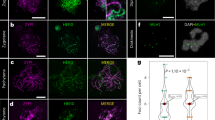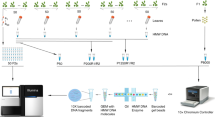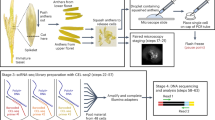Abstract
During meiosis, reciprocal exchange between homologous chromosomes occurs as a result of crossovers (COs). CO frequency varies within genomes and is subject to genetic, epigenetic and environmental control. As robust measurement of COs is limited by their low numbers, typically 1–2 per chromosome, we adapted flow cytometry for use with Arabidopsis transgenic fluorescent protein–tagged lines (FTLs) that express eCFP, dsRed or eYFP fluorescent proteins in pollen. Segregation of genetically linked transgenes encoding fluorescent proteins of distinct colors can be used to detect COs. The fluorescence of up to 80,000 pollen grains per individual plant can be measured in 10–15 min using this protocol. A key element of CO control is interference, which inhibits closely spaced COs. We describe a three-color assay for the measurement of CO frequency in adjacent intervals and calculation of CO interference. We show that this protocol can be used to detect changes in CO frequency and interference in the fancm zip4 double mutant. By enabling high-throughput measurement of CO frequency and interference, these methods will facilitate genetic dissection of meiotic recombination control.
This is a preview of subscription content, access via your institution
Access options
Subscribe to this journal
Receive 12 print issues and online access
$259.00 per year
only $21.58 per issue
Buy this article
- Purchase on Springer Link
- Instant access to full article PDF
Prices may be subject to local taxes which are calculated during checkout






Similar content being viewed by others
References
Page, S.L. & Hawley, R.S. Chromosome choreography: the meiotic ballet. Science 301, 785–789 (2003).
Barton, N.H. & Charlesworth, B. Why sex and recombination? Science 281, 1986–1990 (1998).
Felsenstein, J. The evolutionary advantage of recombination. Genetics 78, 737–756 (1974).
Henderson, I.R. Control of meiotic recombination frequency in plant genomes. Curr. Opin. Plant Biol. 15, 556–561 (2012).
Kauppi, L., Jeffreys, A.J. & Keeney, S. Where the crossovers are: recombination distributions in mammals. Nat. Rev. Genet. 5, 413–424 (2004).
Martini, E., Diaz, R.L., Hunter, N. & Keeney, S. Crossover homeostasis in yeast meiosis. Cell 126, 285–295 (2006).
Cole, F. et al. Homeostatic control of recombination is implemented progressively in mouse meiosis. Nat. Cell Biol. 14, 424–430 (2012).
Berchowitz, L.E. & Copenhaver, G.P. Genetic interference: don't stand so close to me. Curr. Genomics 11, 91–102 (2010).
Jones, G.H. & Franklin, F.C.H. Meiotic crossing-over: obligation and interference. Cell 126, 246–248 (2006).
Copenhaver, G.P., Browne, W.E. & Preuss, D. Assaying genome-wide recombination and centromere functions with Arabidopsis tetrads. Proc. Natl. Acad. Sci. USA 95, 247–252 (1998).
Giraut, L. et al. Genome-wide crossover distribution in Arabidopsis thaliana meiosis reveals sex-specific patterns along chromosomes. PLoS Genet. 7, e1002354 (2011).
Salomé, P.A. et al. The recombination landscape in Arabidopsis thaliana F2 populations. Heredity 108, 447–455 (2012).
Yelina, N.E. et al. Epigenetic remodeling of meiotic crossover frequency in Arabidopsis thaliana DNA methyltransferase mutants. PLoS Genet. 8, e1002844 (2012).
López, E. et al. Looking for natural variation in chiasma frequency in Arabidopsis thaliana. J. Exp. Bot. 63, 887–894 (2012).
Sanchez-Moran, E., Armstrong, S.J., Santos, J.L., Franklin, F.C.H. & Jones, G.H. Variation in chiasma frequency among eight accessions of Arabidopsis thaliana. Genetics 162, 1415–1422 (2002).
Lhuissier, F.G.P., Offenberg, H.H., Wittich, P.E., Vischer, N.O.E. & Heyting, C. The mismatch repair protein MLH1 marks a subset of strongly interfering crossovers in tomato. Plant Cell 19, 862–876 (2007).
Ferdous, M. et al. Inter-homolog crossing-over and synapsis in Arabidopsis meiosis are dependent on the chromosome axis protein AtASY3. PLoS Genet. 8, e1002507 (2012).
Chelysheva, L. et al. An easy protocol for studying chromatin and recombination protein dynamics during Arabidopsis thaliana meiosis: immunodetection of cohesins, histones and MLH1. Cytogenet. Genome Res. 129, 143–153 (2010).
Francis, K.E. et al. Pollen tetrad-based visual assay for meiotic recombination in Arabidopsis. Proc. Natl. Acad. Sci. USA 104, 3913–3918 (2007).
Melamed-Bessudo, C., Yehuda, E., Stuitje, A.R. & Levy, A.A. A new seed-based assay for meiotic recombination in Arabidopsis thaliana. Plant J. 43, 458–466 (2005).
Berchowitz, L.E. & Copenhaver, G.P. Fluorescent Arabidopsis tetrads: a visual assay for quickly developing large crossover and crossover interference data sets. Nat. Protoc. 3, 41–50 (2008).
Francis, K.E., Lam, S.Y. & Copenhaver, G.P. Separation of Arabidopsis pollen tetrads is regulated by QUARTET1, a pectin methylesterase gene. Plant Physiol. 142, 1004–1013 (2006).
Sun, Y. et al. Deep genome-wide measurement of meiotic gene conversion using tetrad analysis in Arabidopsis thaliana. PLoS Genet. 8, e1002968 (2012).
Crismani, W. et al. FANCM limits meiotic crossovers. Science 336, 1588–1590 (2012).
Stahl, F.W. & Lande, R. Estimating interference and linkage map distance from two-factor tetrad data. Genetics 139, 1449–1454 (1995).
Stevens, W.L. The analysis of interference. J. Genet. 32, 51–64 (1936).
Liu, B.H. Linkage, Mapping and QTL Analysis (CRC Press, 1998).
Acknowledgements
Work in the Henderson laboratory is supported by grants from the Royal Society, the Gatsby Charitable Foundation, the Isaac Newton Trust and Biotechnology and Biological Sciences Research Council grant no. BB/K007882/1. Work in the G.P.C. laboratory is supported by grant no. MCB-1121563 from the National Science Foundation. P.A.Z. is supported by grant no. 605/MOB/2011/0 from the Polish Ministry of Science and Higher Education.
Author information
Authors and Affiliations
Contributions
N.E.Y., P.A.Z., N.M. and D.F.M. performed experiments. N.E.Y., P.A.Z., N.M., D.F.M., D.J.M., G.P.C. and I.R.H. designed experiments. N.E.Y., P.A.Z., N.M., X.Z., K.A.K., D.F.M., D.J.M., G.P.C. and I.R.H. analyzed data, performed statistical analysis and wrote the paper.
Corresponding authors
Ethics declarations
Competing interests
The authors declare no competing financial interests.
Integrated supplementary information
Supplementary Figure 1 Crossing schemes to obtain FTLs that can be scored by flow cytometry.
a) Crossing a homozygous FTL (ABC/ABC qrt1-2/qrt1-2) to wild type produces 100% F1 progeny that can be scored. b) Crossing a heterozygous FTL (ABC/+++ qrt1-2/qrt1-2) to wild type produces 50% - r F1 progeny that can be scored, where r corresponds to the proportion of CO recombinants between the FTL T-DNAs. COs between the FTL T-DNAs generate plants that cannot be scored, as they possess 0 or 2 copies of T-DNAs for each colour. c) To test the effect of a mutation of interest (moi) on COs using flow cytometry the mutant should first be crossed to a homozygous or heterozygous FTL of interest as shown in a) and b). Crossing to a homozygous FTL is shown in c). 100% of the F1 from this cross can be scored, but will appear like wild type if moi is recessive. Self-fertilization of these F1 plants will generate 9.375% (6.25% + 3.125%) - r mutant individuals that can be scored in the F2 generation. These schemes assume moi, QRT1 and the FTL intervals are unlinked.
Supplementary Figure 2 Micrographs of pollen sorted by flow cytometry.
a) Hydrated pollen purified by flow cytometry (see Fig. 5c). b) Close-up of hydrated pollen. c) Non-hydrated pollen purified by flow cytometry (see Fig. 5c). d) Close-up of non-hydrated pollen. All scale bars are 50 μM.
Supplementary Figure 3 Flow cytometry acquisition plots showing the effects of gating hydrated and non-hydrated I1bc/+++ pollen.
a) Forward scatter (FSC)/side scatter (SSC) plot of eYFPdsRed/++ pollen, with the R1 gate indicated. The percentage of events in gate R1 is listed. b) Pulse width/side scatter (SSC) plot of eYFPdsRed/++ R1 pollen. Gate R2 contains both hydrated and non-hydrated pollen and represents the population analysed by a FACScan machine during two-colour analysis. Gate R2' is enriched for hydrated pollen. The percentage of events in gates R2 and R2' are listed. c) eYFP (FL1)/dsRed (FL2) plot of eYFPdsRed/++ of R2' (hydrated only) pollen. The percentage of events in each quadrant is indicated in the inset cross diagrams. The R7 quadrant analysed in d) and e) is also shown and the percentage of R7 events listed. d) eYFP (FL1)/dsRed (FL2) plot of eYFPdsRed/++ R2 (non-hydrated and hydrated) pollen. The percentage of events in each quadrant is indicated by the inset cross diagrams. The percentage of events in R7 is listed and is greater than that in plot c). e) R7 pollen from plot d) back-gated to a pulse width/side scatter (SSC) plot. This demonstrates that the majority of events observed in R7 in d) are the non-hydrated pollen that is present in R2 and excluded from R2'.
Supplementary information
Supplementary Figure 1
Crossing schemes to obtain FTLs that can be scored by flow cytometry. (PDF 326 kb)
Supplementary Figure 2
Micrographs of pollen sorted by flow cytometry. (PDF 25276 kb)
Supplementary Figure 3
Flow cytometry acquisition plots showing the effects of gating hydrated and non-hydrated I1bc/+++ pollen. (PDF 1148 kb)
Rights and permissions
About this article
Cite this article
Yelina, N., Ziolkowski, P., Miller, N. et al. High-throughput analysis of meiotic crossover frequency and interference via flow cytometry of fluorescent pollen in Arabidopsis thaliana. Nat Protoc 8, 2119–2134 (2013). https://doi.org/10.1038/nprot.2013.131
Published:
Issue Date:
DOI: https://doi.org/10.1038/nprot.2013.131
This article is cited by
-
MSH2 stimulates interfering and inhibits non-interfering crossovers in response to genetic polymorphism
Nature Communications (2023)
-
A high throughput method for quantifying number and size distribution of Arabidopsis seeds using large particle flow cytometry
Plant Methods (2020)
-
A convenient, rapid and efficient method for establishing transgenic lines of Brassica napus
Plant Methods (2020)
-
Immediate visualization of recombination events and chromosome segregation defects in fission yeast meiosis
Chromosoma (2019)
-
Dynamics of male meiotic recombination frequency during plant development using Fluorescent Tagged Lines in Arabidopsis thaliana
Scientific Reports (2017)
Comments
By submitting a comment you agree to abide by our Terms and Community Guidelines. If you find something abusive or that does not comply with our terms or guidelines please flag it as inappropriate.



